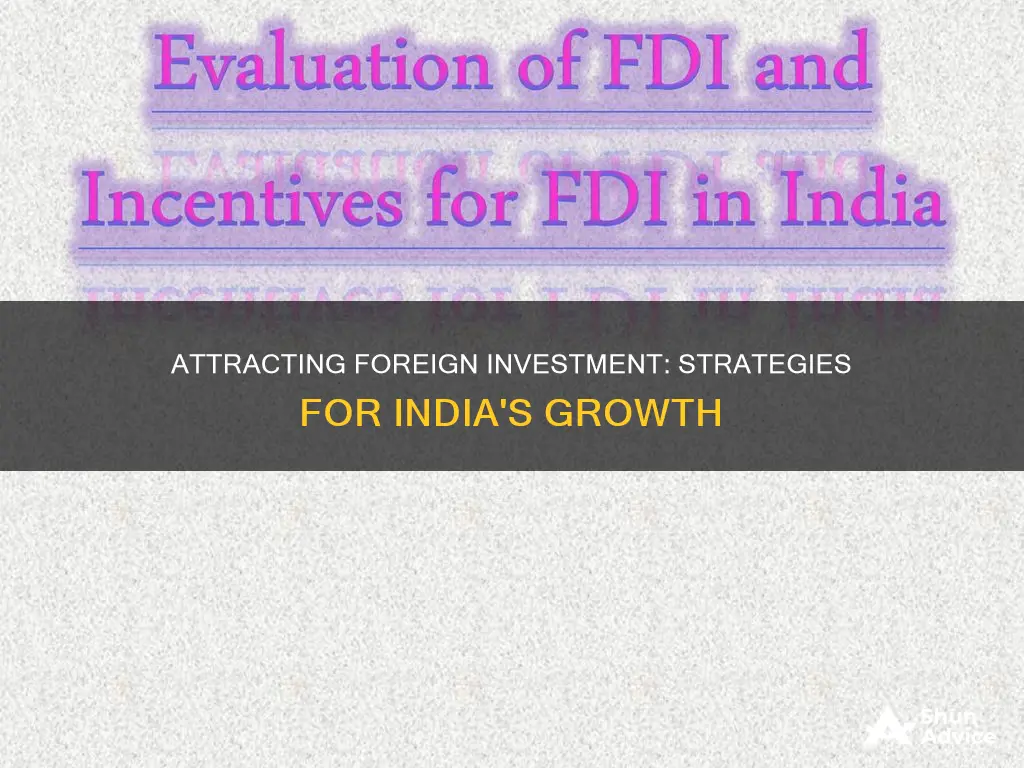
Foreign direct investment (FDI) is a key driver of India's economic growth, providing a substantial non-debt financial source for the country's development. FDI inflows have increased significantly in recent years, with India aiming to attract at least $100 billion annually in gross FDI. The country has implemented numerous structural economic reforms to enhance its business environment and boost FDI, including liberalising restrictions on foreign investment, updating bankruptcy and labour laws, abolishing retroactive taxation, and introducing the Goods and Services Tax (GST).
The Indian government has also introduced a range of policies and initiatives to attract FDI, such as the Make in India campaign, which focuses on simplifying procedures and promoting a favourable investment climate across sectors. Liberalisation of FDI policies, particularly in retail, defence, insurance, and single-brand retail trading, has been a key strategy. Additionally, the government has amended the Foreign Direct Investment (FDI) policy, allowing 100% FDI in specified sub-sectors/activities, including the space sector, to improve the ease of doing business and stimulate investment, income, and employment growth.
India offers a favourable environment for FDI due to its deep-rooted democratic regime, well-developed administration, independent judicial system, vast geography, and educated, hardworking, and skilled workforce. The country also has a growing consumer base and is strategically located near key manufacturing sites and suppliers, making it an attractive base for multinational companies. However, there are still some challenges, including inadequate infrastructure, cumbersome administrative procedures, rigid labour regulations, and high corporate debt.
What You'll Learn
- Liberalising FDI policies in sectors such as retail, defence, insurance, and single-brand retail trading
- Implementing the Goods and Services Tax (GST) to improve transparency
- Creating Special Economic Zones (SEZs) to offer dedicated spaces with tax incentives
- Simplifying procedures and promoting a favourable investment climate across sectors with the Make in India campaign
- Encouraging collaboration on specialised defence technologies with foreign OEMs

Liberalising FDI policies in sectors such as retail, defence, insurance, and single-brand retail trading
Retail
The liberalisation of FDI in the retail sector has had a significant impact on the Indian economy, particularly in promoting diversification and sustainable development. The retail sector in India has witnessed a massive transformation since the early 1990s, with the market value reaching US$500 billion in 2013. The sector is expanding rapidly, with a gradual shift towards organised retailing.
The Indian government has implemented several policy changes to attract FDI in the retail sector. Initially, 100% FDI was allowed in the wholesale cash-and-carry market with automatic approval. Later, in 2006, the government permitted FDI of up to 51% in single-brand retail, subject to prior approval. This decision brought about a significant transformation, with a substantial increase in FDI inflows.
The government further liberalised the sector in 2012, allowing 100% FDI in single-brand retail and 51% in multi-brand retail, with some regulations. This move was aimed at encouraging more investment and modernising the retail sector.
Defence
The defence sector in India has also undergone liberalisation of FDI policies. Initially, FDI in this sector was highly restricted, but the government gradually eased the regulations. As of 2024, FDI of up to 74% is allowed under the automatic route, and anything above that requires government approval.
The defence sector is subject to security clearance by the Ministry of Home Affairs, and foreign investment proposals are scrutinised by the Department for Promotion of Industry and Internal Trade, in consultation with the Ministry of Defence and the Ministry of External Affairs.
Insurance
The insurance sector has seen a significant increase in FDI inflows over the years, thanks to the government's liberalisation efforts. The allowable FDI cap in the insurance sector has been gradually raised over time. In 2014, the cap was increased from 26% to 49%, and in 2021, it was further raised to 74%.
The insurance sector has attracted approximately US$6.51 billion in FDI over the past nine years due to the government's liberalisation of overseas capital flow regulations.
Single-Brand Retail Trading
Liberalising FDI policies in single-brand retail trading has been a key focus area for the Indian government. FDI in this sector is aimed at attracting investments in production and marketing, improving product availability, encouraging sourcing from India, and enhancing competitiveness through access to global designs, technologies, and management practices.
The government has implemented several conditions for FDI in single-brand retail, including a minimum investment of US$100 million, investment in 'back-end infrastructure', and sourcing a certain percentage of goods from Indian micro, small, and medium industries.
Liquid Investment Portfolios: Dynamic, Flexible, and Fluid Capital
You may want to see also

Implementing the Goods and Services Tax (GST) to improve transparency
The Goods and Services Tax (GST) is a significant indirect tax reform implemented in India, coming into effect on 1 July 2017. GST is a single tax levied on the supply of goods and services from the manufacturer to the consumer. It replaces the patchwork of value-added, sales, and excise taxes levied by 29 states and the federal government.
The GST regime has positively impacted India's economy and business environment, and its benefits include:
- Centralized supply chain: GST has given rise to a 'centralized supply' in the value chain, integrating the manufacture of raw materials with the end result of retail to a customer. This allows companies to create centralized supply chain models, resulting in substantial savings in logistics and distribution costs.
- Compliance and formalization of the unorganized sector: GST compels the unorganized sector to comply with tax regulations. It requires all units to be registered with the GSTN to file returns and upload invoices. This helps to formalize a sector that needed transparency and reduces the interface between the client and the tax authority.
- Boost to government revenue: With GST, both the Centre and States are empowered to tax the value addition equally. This provides an impetus to their revenue collections, giving them more funds to allocate as expenditure.
- Improved tax to GDP ratio: GST has simplified the indirect tax structure and eliminated the cascading effect of taxes on customers, making it easier to do business in the country. The increased revenues in the hands of the government are expected to help relieve the cost of capital investments and boost the economy.
- Reduction in the rate of taxation: GST has led to a reduction in the rate of taxation across all sectors, especially for the services sectors. This will compel lower domestic costs and simultaneously attract foreign investment.
- Buoyancy and control in tax collections: There is improved buoyancy and control in tax collections under GST. As per available data, 99.01 lakh taxpayers have been registered under GST so far, and 53.06 lakh returns were filed for the month of November 2017 till the 25th of the month.
- Rise in collection of direct taxes: While GST collections may not be rising, there is a clear indication that businesses are improving their direct tax compliances and organizing their payments towards a centralized indirect taxation structure.
- Financial inclusion: A collateral benefit of GST is financial inclusion. Small and medium enterprises will now have better access to credit as tax payments made electronically can be discounted, and a market for bills can be created.
The implementation of GST, along with other factors such as the liberalization of the FDI policy framework and initiatives like Make in India and Digital India, has contributed to the inflow of foreign capital into India.
Global Investment Factors: What Doesn't Affect International Portfolios?
You may want to see also

Creating Special Economic Zones (SEZs) to offer dedicated spaces with tax incentives
Creating Special Economic Zones (SEZs) can be an effective strategy for attracting foreign direct investment into India. SEZs are designated duty-free enclaves that offer a range of tax incentives and benefits to businesses operating within them. Here are some key features and advantages of establishing SEZs to attract foreign investment:
Dedicated Spaces and Tax Incentives
- SEZs are designated as duty-free enclaves, providing a favourable environment for businesses looking to minimise costs associated with importing raw materials and components.
- Units within SEZs enjoy 100% income tax exemption on export income for the first five years, followed by 50% for the next five years, and then 50% of the ploughed-back export profit for the subsequent five years. (Please note that a sunset clause for units will become effective from 01.04.2020)
- SEZ developers and units are exempt from Minimum Alternate Tax (MAT) and Dividend Distribution Tax (DDT), providing further tax relief.
- Central and state-level approvals are streamlined through a single-window clearance system, reducing bureaucratic hurdles.
- SEZ developers benefit from income tax exemptions on income derived from the business of developing the SEZ for a block of 10 years within a period of 15 years.
- Supplies to SEZ units are zero-rated under the IGST Act, 2017, offering additional tax advantages.
- Exemptions from customs and excise duties are provided for the development of SEZs, reducing costs for authorised operations.
- Full freedom for subcontracting is permitted within SEZs, providing operational flexibility.
- Routine examinations by customs authorities on export/import cargo are not required, simplifying trade procedures.
Additional Benefits
- SEZs can house various types of business activities within a single sector if they involve similar products or services, allowing for a diverse range of industries to benefit from the incentives.
- Minimum area requirements for establishing SEZs have been reduced, making it more accessible for businesses to set up operations within these zones.
- SEZs are typically located close to significant ports, providing excellent shipping and rail infrastructure connectivity.
- The final product manufactured or assembled within SEZs can be sold both domestically and exported, offering flexibility in market reach.
Saving and Investment Economics: Core Concepts Explained
You may want to see also

Simplifying procedures and promoting a favourable investment climate across sectors with the Make in India campaign
The Make in India campaign was launched by the Prime Minister in September 2014 as part of a wider set of nation-building initiatives. The aim was to transform India into a global design and manufacturing hub. The campaign has four pillars, which have been identified to boost entrepreneurship in India, not only in manufacturing but also in other sectors.
The first pillar is new processes. 'Make in India' recognizes 'ease of doing business' as the single most important factor to promote entrepreneurship. A number of initiatives have been undertaken to ease the business environment. The aim is to de-license and de-regulate the industry during the entire life cycle of a business. This includes streamlining and rationalizing licensing rules at the state government level, aligning them with global best practices.
The second pillar is new infrastructure. The availability of modern and facilitating infrastructure is a very important requirement for the growth of the industry. The government intends to develop industrial corridors and smart cities to provide infrastructure based on state-of-the-art technology with modern high-speed communication and integrated logistic arrangements.
The third pillar is new sectors. Make in India has identified 25 sectors in manufacturing, infrastructure, and service activities. FDI has been opened up in a big way in defence production, construction, and railway infrastructure.
The fourth pillar is a new mindset. The government will partner with the industry in the economic development of the country, acting as a facilitator rather than a regulator.
The Make in India program has resulted in a transparent and user-friendly system that is helping to drive investment, foster innovation, develop skills, protect IP, and build best-in-class manufacturing infrastructure. It has also opened up key sectors, including railways, defence, insurance, and medical devices, to dramatically higher levels of Foreign Direct Investment.
Attorneys: Managing Alternative Investments for Financial Success
You may want to see also

Encouraging collaboration on specialised defence technologies with foreign OEMs
India has implemented a range of policies and initiatives to encourage foreign direct investment (FDI) in the country. The "Make in India" campaign, for example, focuses on simplifying procedures and promoting a favourable investment climate across sectors. Liberalization of FDI policies, particularly in retail, defence, insurance, and single-brand retail trading, has been a key strategy. The Goods and Services Tax (GST) implementation has improved transparency, while Special Economic Zones (SEZs) provide dedicated spaces with tax incentives.
The Indian government has also taken steps to encourage collaboration on specialised defence technologies with foreign OEMs. The government has set a target of Rs. 1.75 lakh crores of defence production by 2025, which includes the export of Rs. 35,000 crores. The Budget outlay for Financial Year 2023 has been fixed at Rs. 5.3 trillion, about a 10% increase over last year. The government has reserved the production of certain arms and ammunition for making in India, while other items are open for FDI.
The FDI policy in the defence sector permits FDI via automatic approval of up to 74%. The Indian government reserves the review rights for any foreign investment in the defence manufacturing sector that inspires national security. It is required in the national interest. The inflow of FDI is far better than debt, as it will push for growth and development, transform India into a manufacturer, bring technological advancement, and make the economy more open.
Change Management: Invest in Your Business's Future Success
You may want to see also
Frequently asked questions
Some of the main advantages of FDI in India include a deep-rooted and highly effective democratic regime, a well-developed administration and an independent judicial system, an educated and skilled workforce, a large and ever-growing consumer base, proximity to key manufacturing sites and suppliers, and relatively competitive labour costs.
Some of the main disadvantages of FDI in India include a lack of adequate infrastructure, cumbersome and slow administrative procedures, rigid labour regulations, high corporate debt and non-performing assets, weak public finances, and excessive bureaucracy.
Some recent examples of FDI inflows into India include investments from Taiwanese companies, Hyundai Motors' acquisition of General Motors India's Talegaon plant, and Singapore Airlines acquiring a 25.1% share in Air India.
There are mainly two types of FDI: Horizontal and Vertical. Horizontal FDI occurs when a business expands its domestic operations to another country, while Vertical FDI happens when a business expands into another country by moving to a different level of the supply chain. Two other types of FDI are Conglomerate and Platform FDI.
FDI in India can be made through the Automatic Route or the Government Route. The Automatic Route does not require prior approval from the Government or the Reserve Bank of India, while the Government Route requires approval from the respective ministry overseeing the concerned sector, along with the agreement of the Department for Promotion of Industry and Internal Trade (DPIIT).







